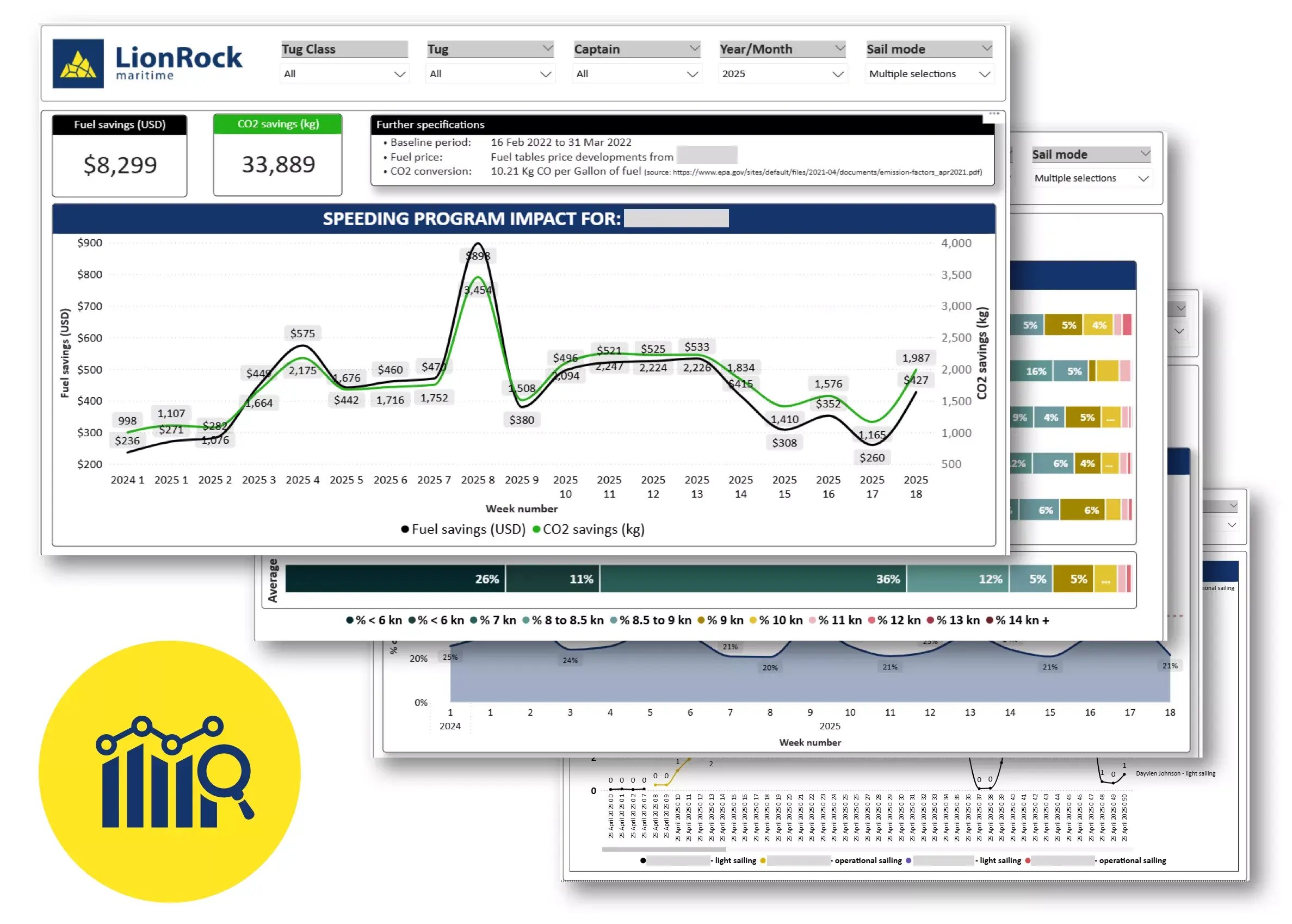
Reports: PowerCaptain
Speed Monitoring Dashboard
Tugboat operations during light sailing often exceed eco-efficient speed limits, leading to unnecessary fuel use and emissions. The Speed Monitoring Dashboard provides fleet-wide and individual-level insights into these patterns. It visualizes compliance trends, ranks captains and vessels by performance, and quantifies weekly and cumulative savings in both fuel costs and CO₂ reductions. With color-coded comparisons and transparent baseline metrics, the dashboard helps managers target improvements, reduce excessive speeds, and drive both environmental and financial benefits across port operations.
Impressive stat goes here
Impressive stat goes here
Impressive stat goes here
Impressive stat goes here
Report overview
How the Speed Monitoring Dashboard can help your business
This report presents an example analysis using LionRock Maritime’s Speed Monitoring Dashboard, powered by PowerCaptain, to demonstrate how tugboat speed compliance can be monitored and optimized. The dashboard tracks light sailing behavior across fleet, vessel, and captain levels, highlighting patterns of excessive speed and their operational impact. In this illustrative case, speeding was reduced from a baseline average of 41% to 16%, resulting in estimated savings of over €63,000 in fuel costs and nearly 250,000 kg of CO₂ emissions p.a. avoided. These figures showcase the potential benefits of data-driven speed management in improving efficiency, accountability, and sustainability in port operations.
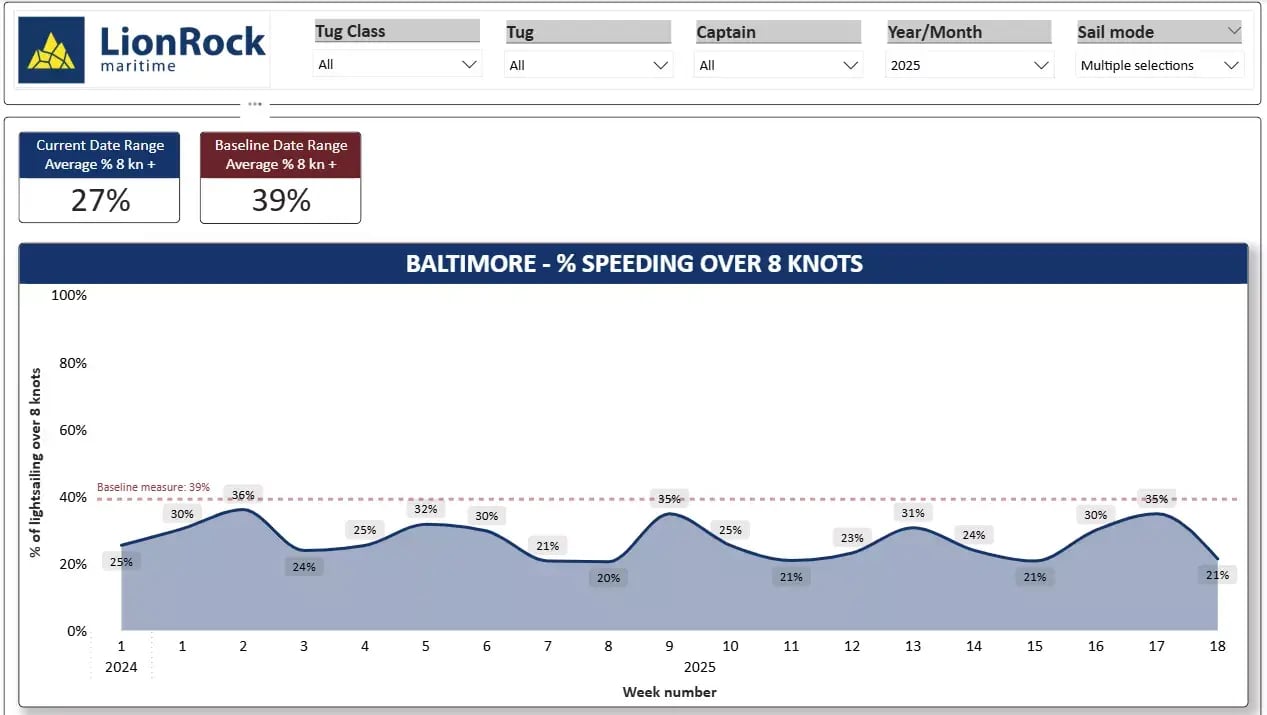
Insight 1
Lightsailing speed development over time
The plot illustrates the percentage of light sailing time during which tugboats exceeded an eco-efficient speed threshold, offering insight into operational behavior and compliance with speed regulations. It measures the proportion of time vessels, while not engaged in towing or assisting, operated above the recommended speed—typically 8 knots—based on a weighted fleet average within a specific port. Such graphs are valuable for tracking changes in operational practices over time, using a baseline as a reference. In this case, the data shows a clear reduction in excessive speed occurrences, indicating improved compliance likely driven by enhanced monitoring and a growing emphasis on eco-efficiency.
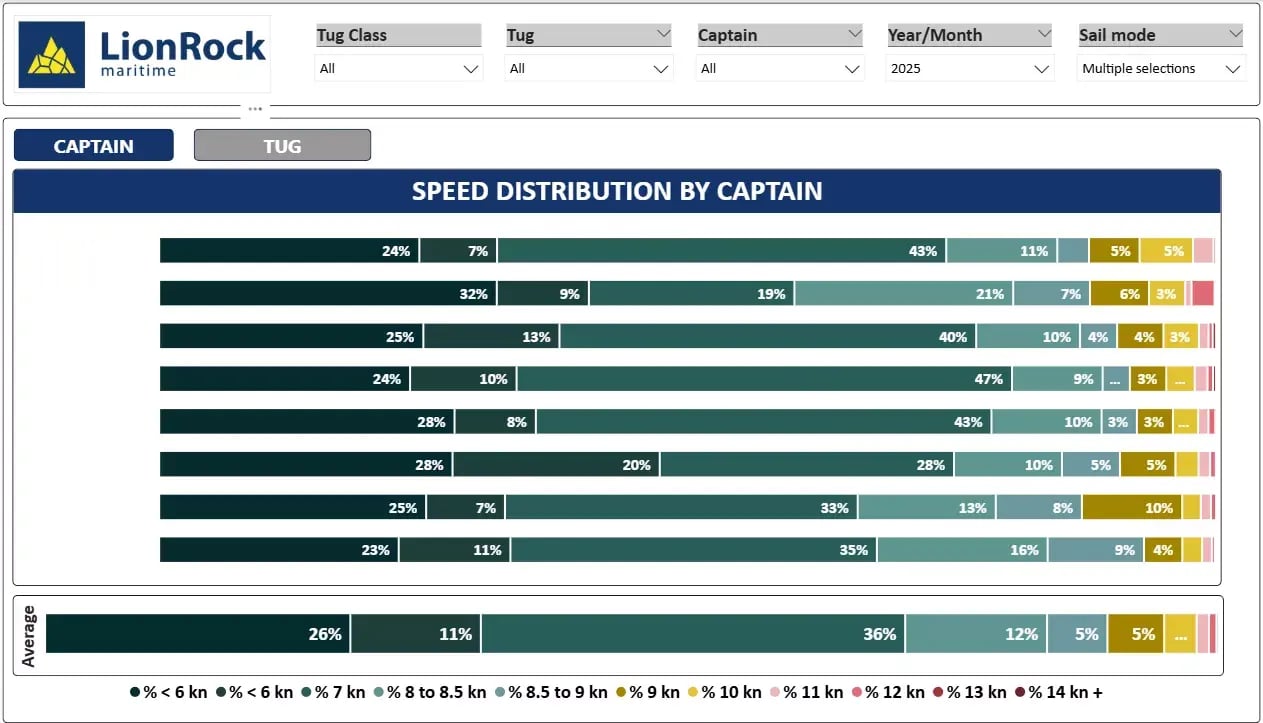
Insight 2
Lightsailing speeds by captain
This chart compares individual captains’ performance by showing the percentage of light sailing time spent above the eco-efficient speed threshold of 8 knots. Each bar represents a captain, with color-coding—green for low, yellow to red for high—highlighting compliance levels. The visualization reveals behavioral differences across the fleet, identifying both high performers and those needing improvement. It serves as a practical tool for promoting accountability, guiding targeted training, and improving overall operational efficiency.
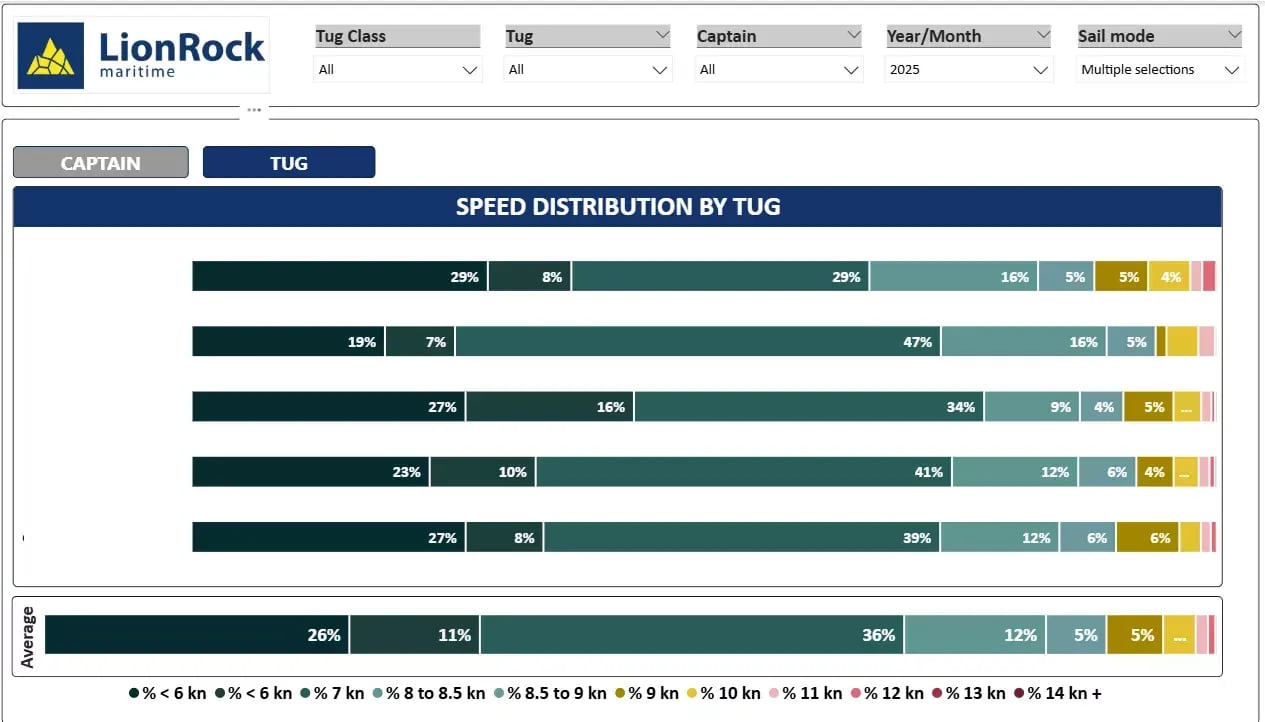
Insight 3
Lightsailing speeds by tug
This chart compares tugboat performance by showing the percentage of light sailing time each vessel spent above the 8-knot eco-efficient speed threshold. It highlights variability across the fleet, with some tugs maintaining low speeding rates while others show higher non-compliance. This allows fleet managers to identify specific vessels for targeted monitoring or operational improvements, supporting more efficient, eco-friendly, and cost-effective operations.
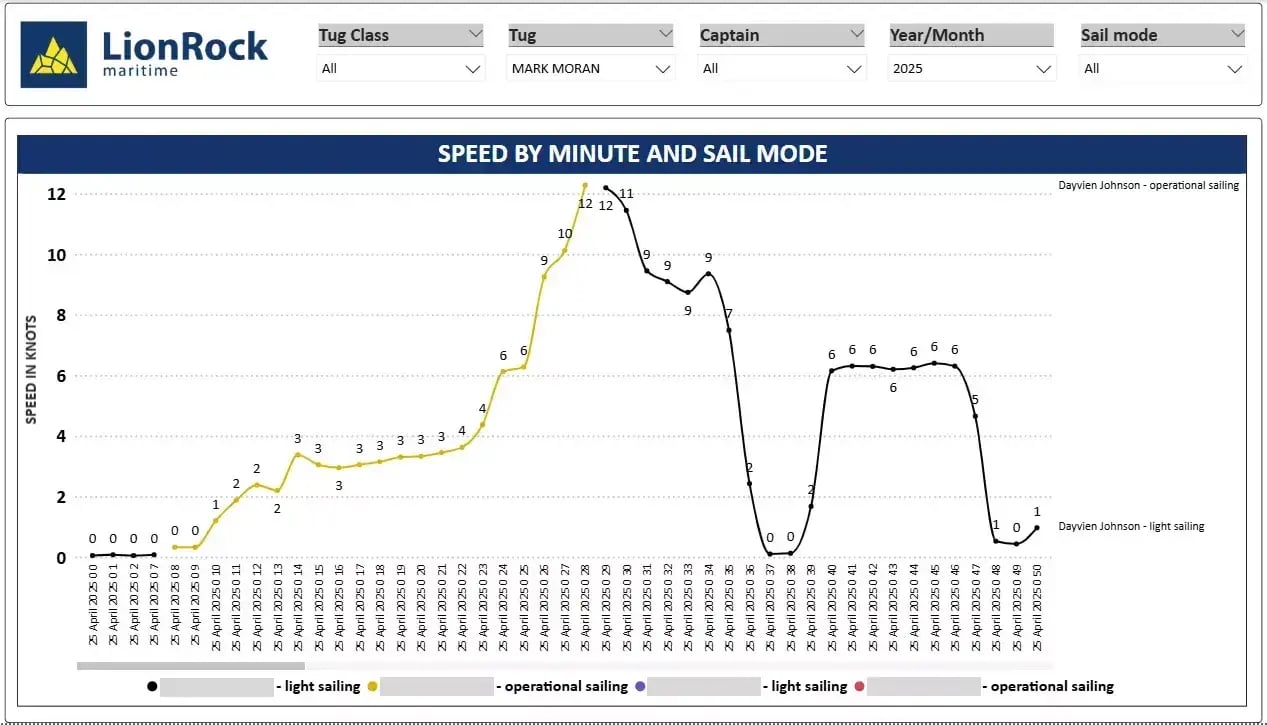
Insight 4
Detailed speed tracks
This overview gives you detailed speed tracks segmented by lightsailing vs operational sailing by captain. It is a great indication whether speeding was necessary because of a back-to-back job or that it could have been avoided by leaving on time and/or better planning.
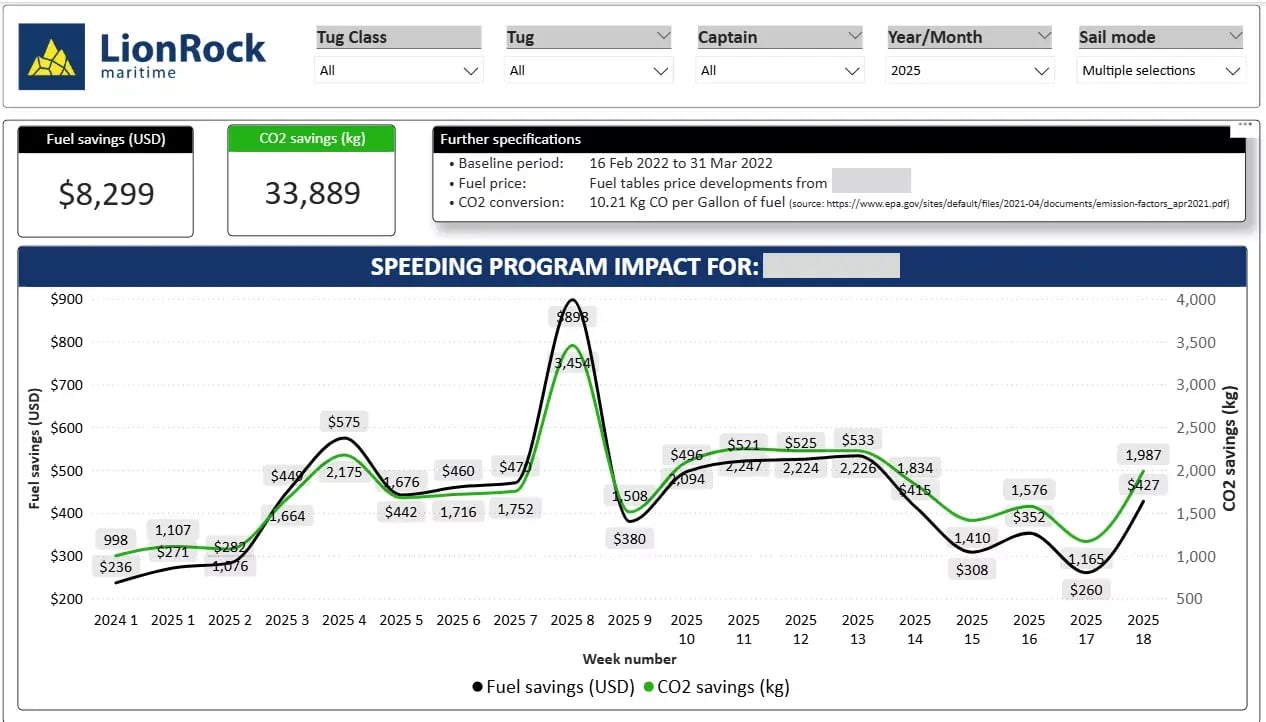
Insight 5
Savings calculation
This graph shows the financial and environmental benefits of reducing excessive tugboat speeds in the port, with fuel savings tracked by the black line and CO2 reductions by the green line. Weekly data highlights how eco-efficient speed management leads to both cost savings and lower emissions. Peaks and trends offer insight into the effectiveness of operational strategies, while accompanying data—such as baseline periods and CO2 conversion rates—ensures transparency. Overall, the chart demonstrates how consistent speed compliance can deliver significant economic and environmental gains.
Included Reports
Insights we provide:
- Lightsailing speed development over time
- Lightsailing speeds by captain
- Lightsailing speeds by tug
- Detailed speed tracks
- Savings calculation
We Have Answers
Frequently Asked Questions
Lorem ipsum dolor sit amet, consectetuer adipiscing elit?
Donec nec justo eget felis facilisis fermentum. Aliquam porttitor mauris sit amet orci. Aenean dignissim pellentesque felis. Praesent dapibus, neque id cursus faucibus, tortor neque egestas auguae, eu vulputate magna eros eu erat. Aliquam erat volutpat.
Donec nec justo eget felis facilisis fermentum?
Donec nec justo eget felis facilisis fermentum. Aliquam porttitor mauris sit amet orci. Aenean dignissim pellentesque felis. Praesent dapibus, neque id cursus faucibus, tortor neque egestas auguae, eu vulputate magna eros eu erat. Aliquam erat volutpat.
Lorem ipsum dolor sit amet, consectetuer adipiscing elit?
Donec nec justo eget felis facilisis fermentum. Aliquam porttitor mauris sit amet orci. Aenean dignissim pellentesque felis. Praesent dapibus, neque id cursus faucibus, tortor neque egestas auguae, eu vulputate magna eros eu erat. Aliquam erat volutpat.
Donec nec justo eget felis facilisis fermentum?
Donec nec justo eget felis facilisis fermentum. Aliquam porttitor mauris sit amet orci. Aenean dignissim pellentesque felis. Praesent dapibus, neque id cursus faucibus, tortor neque egestas auguae, eu vulputate magna eros eu erat. Aliquam erat volutpat.
PowerCaptain
Other related Reports


